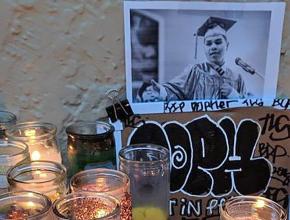99 bullets and one dead teen
and report from San Francisco on community outrage following the police murder of an undocumented teen.
TEN OFFICERS. Ninety-nine rounds.
That's the tally of gunfire that police used to kill 19-year-old Jesus Adolfo Delgado-Duarte on March 6 in San Francisco's Mission District.
The police killing--the first of 2018 by police in the Mission--has drawn attention because of the overwhelming use of force by officers, who unleashed a barrage of bullets into the trunk of a car that Delgado was allegedly attempting to hide in. Delgado-Duarte was struck by at least 20 bullets of the 99 fired.
Police claim Delgado-Duarte was a suspect in a robbery and that he had fired a gun from inside the trunk of the car. Astonishingly, police opened fire despite the fact that an 18-year-old woman was in the car's passenger seat at the time--she was miraculously not harmed.
The killing has also drawn attention because of the fact that Delgado-Duarte was a DREAMer--a young undocumented immigrant brought to the U.S. as a small child. Friends told MissionLocal.org that his biggest fear was being deported--and speculated that this was the reason why he tried to hide in the trunk of the car.

Though San Francisco is supposedly a "sanctuary city" for undocumented immigrants, that means little if immigrants can be executed by a police department that operates like an occupying force in the rapidly gentrifying Mission District.
A WEEK after the killing, San Francisco Police Chief William Scott, alongside an assortment of city officials, lawyers and officers, attended a community meeting at Cesar Chavez Elementary School. Multiple videos of the shooting were played in an attempt to justify it to grieving family members and a furious community.
The body camera footage was shown to more than 200 people at the meeting, who had turned out after pleas for justice from Delgado-Duarte's family. Residents reacted with pain and anger--shouting "murderers!" in Spanish--as they watched video clips in which the teenager was gunned down by police.
A Justice for Jesus Adolfo Coalition brought together union members, teachers, health care professionals and members of a local cop watch group to stand up against police violence. As the meeting began, outrage brimmed under weary greetings and murmurs of "Here we are again" by those in attendance.
Community members expressed solidarity with Delgado-Duarte's family and broke down the systemic nature of the struggle against police violence in their community. Noting that Jesus' killers were the latest example of police killings involving multiple officers, one woman observed that "[Police] feed on each other's anger and hatred, and it's racism."
Mainstream media outlets largely succumbed to pressure to relay the police narrative of events. They use "copspeak"--passive language and suggestive police jargon--to help "explain" the killing as Delgado-Duarte's fault.
Headlines focused on the release of the sensational videos--and in most cases completely omitted the outpouring of anger of the hundreds in attendance at the town hall.
Once the police gave the microphone over to community members to speak, a line formed, and people spoke out against police brutality to cheers, roars and chants from the audience.
One officer stationed himself at the front of the line, but retreated within minutes under the collective scorn of the hundreds in attendance.
One of Delgado-Duarte's family members called out a female officer sitting with Chief Scott for acting bored during the meeting, even as multiple people spoke about the pain her department caused. Anyone who was bored should leave, the family member suggested--and a cacophony of jeers followed the officer out of the room.
Another attendee singled out an official with the Department of Police Accountability for taking no notes, even as the local community related a lengthy list of grievances with the police and gave crucial insight into the way police violence affects the Mission.
THOSE AT the meeting weren't hopeful about the system holding any police or officials accountable for Delgado-Duarte's killing, suggesting that justice will only come with more direct action.
One suggestion was to make police violence a central issue in San Francisco's upcoming mayoral election. But one person present explained, "It doesn't matter who we elect, they'll turn a blind eye and sweep these murders under the rug."
Others called for a cut to the police funding. "If you want to get them, cut their funding. Give it to teachers," said one person.
Many of the speakers and community members present had been active in the fight to oust former Chief Greg Suhr following a string of police murders of other Black and Brown San Francisco residents, including Mario Woods, Luis Gongora Pat and Jessica Williams.
Chief Scott, Suhr's replacement, has so far been a sad excuse for a supposed "reformer." The same tactics of direct action and mass organizing that led to his predecessor's ouster may be reborn in the course of collective struggle fighting for justice for Jesus Delgado-Duarte.


